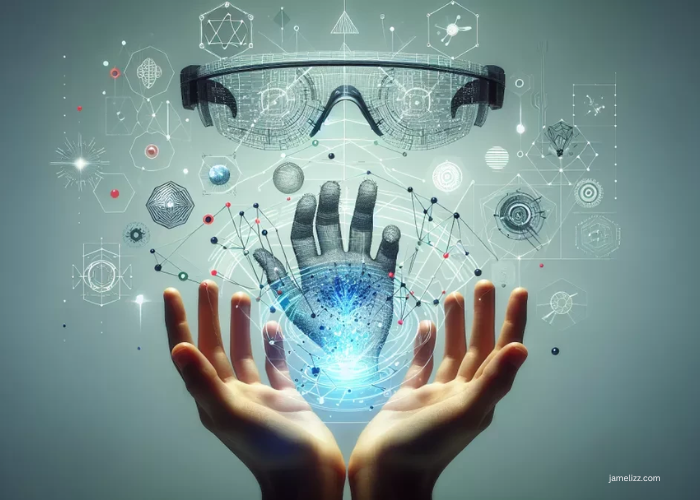Augmented Reality (AR) is revolutionizing the way we interact with our environment by seamlessly blending digital elements with the physical world. Unlike Virtual Reality (VR), which immerses users in a completely virtual environment, AR enhances our real-world surroundings with digital overlays, offering a unique and interactive experience. As AR technology continues to evolve, its potential applications are expanding across various industries, from gaming and entertainment to education, healthcare, retail, and beyond. This article explores the concept of AR, its history, applications, and the future impact it might have on society.
Understanding Augmented Reality
At its core, Augmented Reality is the technology that superimposes computer-generated images, sounds, or other data onto the real world, enhancing a person’s perception of their environment. AR technology utilizes devices such as smartphones, tablets, and AR glasses to overlay digital content on top of the physical world. This digital content can range from simple text and images to complex 3D models and animations that interact with real-world objects.
The essence of AR lies in its ability to provide contextual information in real time. For example, an AR application on a smartphone might allow a user to point their camera at a historic monument and instantly see relevant historical data or a reconstruction of what the site looked like in the past. This fusion of digital and physical realms creates a rich, layered experience that can enhance learning, entertainment, and functional activities.
A Brief History of Augmented Reality
The concept of Augmented Reality can be traced back to the 1960s when computer scientist Ivan Sutherland developed the first head-mounted display system, which he referred to as the “Sword of Damocles.” This early prototype laid the groundwork for future developments in both VR and AR technologies. However, the term “Augmented Reality” was not coined until the early 1990s by Tom Caudell, a researcher at Boeing, who used AR to help workers assemble intricate aircraft wiring systems.
Throughout the 1990s and 2000s, AR continued to develop primarily in academic and industrial settings. It wasn’t until the advent of smartphones and the proliferation of high-speed internet that AR began to capture the public’s imagination. In 2016, AR gained widespread popularity with the release of Pokémon GO, a mobile game that allowed players to capture virtual creatures in the real world using their smartphone cameras. This marked a pivotal moment for AR, demonstrating its potential for mainstream entertainment and interaction.
Applications of Augmented Reality
AR technology has far-reaching applications across numerous sectors, transforming the way we live, work, and play. Some of the key industries benefiting from AR include:
Gaming and Entertainment
The gaming industry was one of the first to embrace AR technology, and it continues to be a driving force behind its development. Games like Pokémon GO and Harry Potter: Wizards Unite have demonstrated how AR can turn the real world into a playground, blending digital characters and narratives with physical locations. AR has also extended into other forms of entertainment, including interactive museum exhibits and live events, where digital enhancements provide an immersive experience.
Education and Training
In education, AR is opening new avenues for interactive learning. By overlaying digital information onto physical objects or locations, AR can provide students with immersive, hands-on learning experiences that traditional methods cannot match. For instance, medical students can use AR to visualize and interact with 3D models of the human anatomy, providing a deeper understanding of complex biological systems. In vocational training, AR can simulate real-world scenarios, allowing trainees to practice and hone their skills in a controlled environment.
Healthcare
AR is making significant strides in healthcare, from assisting surgeons during operations to enhancing patient care. Surgeons can use AR to project digital images of a patient’s anatomy onto their body, providing a detailed, real-time guide during complex procedures. AR is also being used in physical therapy, where virtual exercises and feedback can help patients recover more effectively. Moreover, AR can improve patient education by visualizing medical conditions and treatments in a more understandable way.
Retail and E-commerce
The retail industry is leveraging AR to create more engaging and personalized shopping experiences. With AR, customers can visualize how products will look and fit in their homes or on their bodies before making a purchase. For example, furniture retailers like IKEA use AR apps that allow customers to place virtual furniture in their homes to see how it fits with their existing decor. Similarly, beauty brands use AR to let customers try on makeup virtually, enhancing the online shopping experience.
Manufacturing and Maintenance
AR is proving to be a valuable tool in manufacturing and maintenance, providing workers with real-time guidance and information. By overlaying digital instructions onto physical equipment, AR can streamline complex assembly processes and reduce errors. In maintenance, AR can provide technicians with instant access to repair manuals and diagnostics, improving efficiency and reducing downtime. This capability is particularly beneficial in sectors like aerospace and automotive, where precision and reliability are crucial.
The Future of Augmented Reality
As AR technology continues to advance, its impact on society is expected to grow exponentially. The future of AR is likely to be shaped by several key trends:
Advancements in Hardware and Software
The development of more advanced AR hardware, such as AR glasses and contact lenses, will make AR experiences more seamless and immersive. These devices will likely become more compact, comfortable, and affordable, increasing their adoption in both consumer and enterprise markets. On the software side, advancements in artificial intelligence (AI) and machine learning will enhance AR’s ability to understand and interact with the physical world, making AR applications more intelligent and responsive.
Integration with Other Technologies
AR is set to benefit from its integration with other emerging technologies, such as 5G, AI, and the Internet of Things (IoT). 5G’s high-speed, low-latency connectivity will enable more complex and data-intensive AR applications, while AI will enhance AR’s ability to recognize and interpret the environment. The integration of AR with IoT devices will allow for more dynamic and context-aware experiences, where digital information can be overlaid on real-world objects based on their current state and location.
Expansion into New Industries
While AR is already making an impact in several industries, its potential applications are far from exhausted. The technology is likely to expand into new areas, such as architecture, tourism, and remote collaboration. In architecture, AR can be used to visualize building designs in real-world environments, helping architects and clients better understand how a structure will look and feel. In tourism, AR can enhance travel experiences by providing rich, interactive information about historical sites and landmarks. For remote collaboration, AR can enable virtual meetings where participants interact with 3D models and data as if they were in the same room.
Ethical and Privacy Considerations
As AR technology becomes more pervasive, it will also raise important ethical and privacy considerations. The ability to overlay digital content onto the physical world could lead to issues around data security, surveillance, and consent. For example, AR applications that collect and share location-based data could potentially infringe on user privacy. As such, it will be crucial for developers, regulators, and society as a whole to address these challenges and establish guidelines that protect user rights while fostering innovation.
Conclusion
Augmented Reality is at the forefront of a digital revolution, merging the physical and digital worlds in ways that were once the stuff of science fiction. As AR technology continues to evolve, it holds the promise of transforming various aspects of our lives, from how we learn and work to how we shop and entertain ourselves. While the path forward will undoubtedly present challenges, the potential benefits of AR make it a technology worth watching and investing in. As we stand on the cusp of this new digital frontier, one thing is clear: Augmented Reality is not just a trend; it is a glimpse into the future of human interaction with the world.



